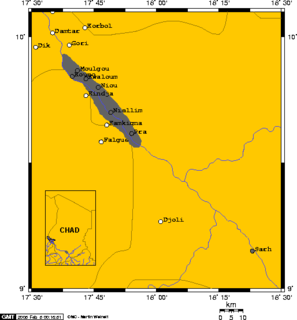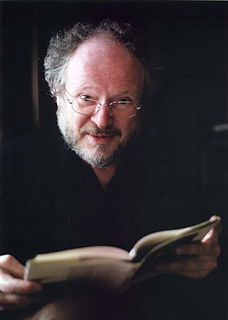Related Research Articles

Dyula is a language of the Mande language family spoken in Burkina Faso, Ivory Coast and Mali. It is one of the Manding languages and is most closely related to Bambara, being mutually intelligible with Bambara as well as Malinke. It is a trade language in West Africa and is spoken by millions of people, either as a first or second language. Similar to the other Mande languages, it uses tones. It may be written in the Latin, Arabic or N'Ko scripts.

Shawiya, or Shawiya Berber, also spelt Chaouïa, is a Zenati Berber language spoken in Algeria by the Shawiya people. The language's primary speech area is the Awras Mountains in eastern Algeria and the surrounding areas, including Batna, Khenchela, Sétif, Oum El Bouaghi, Souk Ahras, Tébessa and the northern part of Biskra. It is closely related to the Shenwa language.
The Bua languages are a subgroup of the Mbum–Day subgroup of the Savanna languages spoken by fewer than 30,000 people in southern Chad in an area stretching roughly between the Chari River and the Guéra Massif. They were labeled "G13" in Joseph Greenberg's Adamawa language-family proposal. They are ultimately part of the Niger–Congo family, and have exerted a significant influence on Laal.

The Niellim language is a Bua language spoken by some 5,000 people along the Chari River in southern Chad. It is mainly spoken in two areas: one around the city of Sarh and one, its traditional home, further north, between about 9°30′ and 9°50′ N, corresponding to the former chiefdoms of Pra, Niellim, and Niou.
Kabiye is an Eastern Gurunsi Gur language spoken primarily in northern Togo. Throughout the 20th century, there was extensive migration to the centre and south of Togo and also to Ghana and Benin. Kabiye speakers made up over 23% of the Togolese population in 1999.
Kituba is a widely used lingua franca in Central Africa. It is a creole language based on Kikongo, a Bantu language. It is a national language in Republic of the Congo and Democratic Republic of the Congo.
Luba-Katanga, also known as Luba-Shaba and Kiluba, is one of the two major Bantu languages spoken in the Democratic Republic of the Congo called "Luba". It is spoken mostly in the south-east area of the country by the Luba people.

Henri Wittmann is a Canadian linguist from Quebec. He is best known for his work on Quebec French.
Magoua, which may derive from a word in Atikamekw: Makwa French: huard) which means loon, is a particular dialect of basilectal Quebec French spoken in the Trois-Rivières area, between Trois-Rivières and Maskinongé. Long before a military fort was constructed there, Trois-Rivières became in 1615 the first stronghold of the coureurs des bois outside the city of Québec. Magoua is the ethnonym applied to their descendants in the area. Magoua is the most conservative of all Quebec French varieties, including Joual. It preserves the sontaient ("étaient") characteristic of Métis French and Cajun French, has a creole-like past tense particle tà and has old present-tense contraction of a former verb "to be" that behave in the same manner as subject clitics.
Dangaléat is an Afro-Asiatic language spoken in central Chad. Speakers make up the majority of the population of Migami Canton in Mongo, Chad.
Mohamed Ahmed-Chamanga, is a Comorian linguistic, writer, researcher, politic and professor born in Ouani (Nzwani) in 1952.
The Bongo–Bagirmi or Sara–Bongo–Bagirmi languages are the major branch of the Central Sudanic language family with about forty languages. Principal groups include Bagirmi languages such as Naba and the Sara languages. They are spoken across CAR, Chad, South Sudan, and adjacent countries.
Safene (Saafen), Safi or Saafi-Saafi, is the principal Cangin language, spoken by 200,000 people in Senegal. Speakers are heavily concentrated in the area surrounding Dakar, particularly in the Thies Region.
The official language of the Republic of Congo is French. Other languages are mainly Bantu languages, and the two national languages in the country are Kituba and Lingala, followed by Kongo languages, Téké languages, and more than forty other languages, including languages spoken by Pygmies, which are not Bantu languages.
Siamou, also known as Sɛmɛ (Seme), is a language spoken mainly in Burkina Faso. It is unclassified within the proposed Niger–Congo language family and could likely be a language isolate
Mbandja is the largest of the Banda languages. There are 350,000 speakers in DRC, 10,000 in the Republic of Congo, and an unknown number in CAR.
Lehar or Laalaa is one of the Cangin languages spoken in Senegal in the Laa region, north of Thies as well as the Tambacounda area. The speakers are ethnically Serers, however just like the Ndut, Palor, Saafi and Noon languages, they are closely related to each other than to the Serer-Sine language. The Lehar language which is closer to Noon, is part of the Niger–Congo family. The number of speakers based on 2002 figures were 10,925.
Claude Buridant is a French linguist, professor emeritus of French and Romance philology at the University of Strasbourg in Strasbourg. He is director of the Centre for Linguistics and Romance Philology in Strasbourg.
Jean Dubois was a French linguist, grammarian and lexicographer.
The following is a timeline of the history of the city of Lubumbashi, Democratic Republic of the Congo.
References
- ↑ Taabwa at Ethnologue (18th ed., 2015) (subscription required)
- ↑ Jouni Filip Maho, 2009. New Updated Guthrie List Online